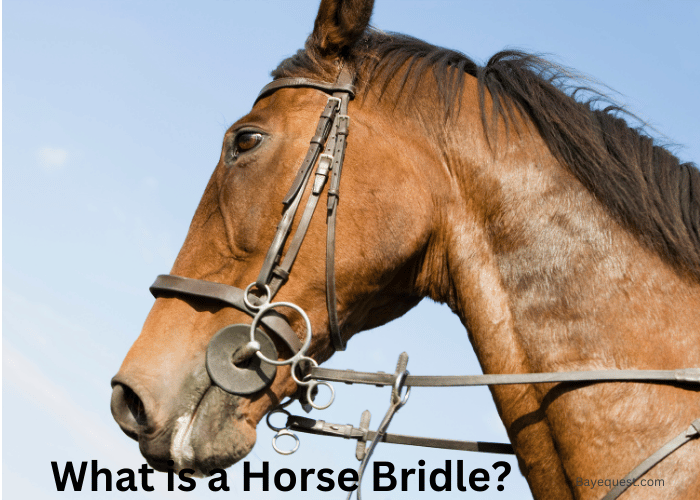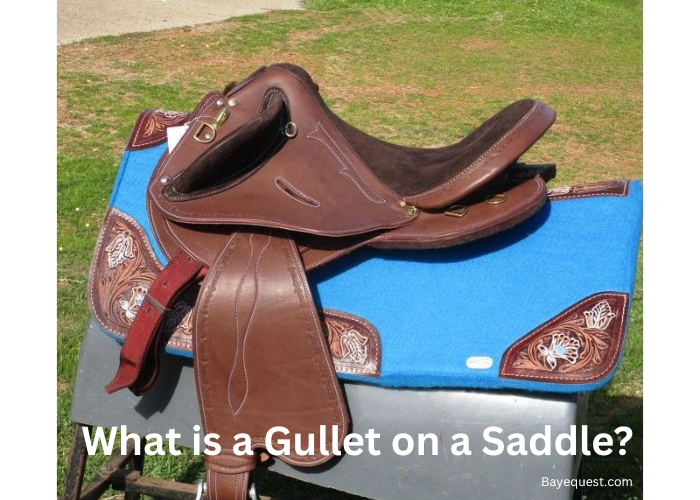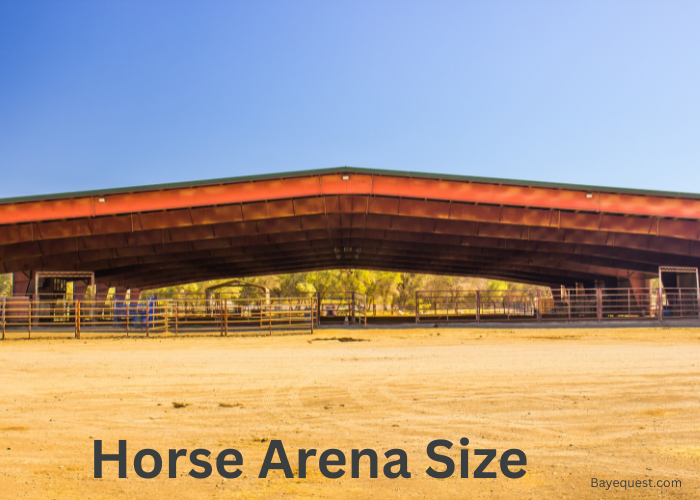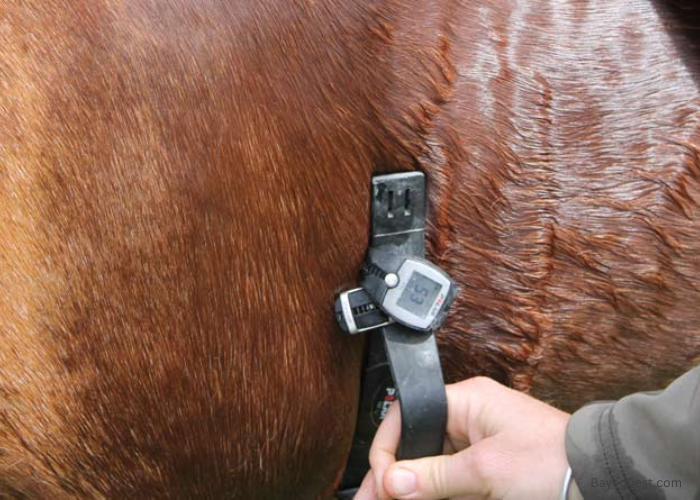A horse bridle is more than just a set of straps and buckles. It’s a crucial link between horse and rider, providing control and communication.
Ever wondered how riders steer their majestic companions with such precision? The secret lies in the bridle.
In this blog, we’ll explain what a horse bridle is, its key parts, and why it’s essential for any rider. Ready to unravel the mystery of bridles?
Let’s dive in.
What is a Horse Bridle?
A horse bridle is a piece of equipment used to direct a horse. It consists of several components, including the headstall, bit, reins, browband, noseband, and cheekpieces.
The headstall fits around the horse’s head and holds the bit in the horse’s mouth. The reins, attached to the bit, allow the rider to communicate with and guide the horse.
Bridles come in various styles, such as English and Western, each suited to different riding disciplines and preferences.
A well-fitted bridle ensures the horse’s comfort and effective communication between horse and rider.
Read also: Western Vs English Riding
Parts of a Bridle
A horse bridle comprises several essential parts, each playing a specific role in controlling and communicating with the horse. Here are the main components:
Headstall
The headstall is the central piece of the bridle, fitting around the horse’s head to hold everything in place.
It consists of straps that go over the horse’s poll (the top of the head behind the ears) and has cheekpieces that run down the sides of the horse’s face.
The headstall’s main function is to support and secure the bit, reins, browband, and noseband, ensuring they stay in their proper positions.
Bit
The bit is a metal piece that fits into the horse’s mouth and is attached to the headstall through the cheekpieces.
Its primary purpose is to provide a means of communication between the rider and the horse.
When the rider pulls on the reins, the bit exerts pressure on the horse’s mouth, helping to guide and control the horse’s movements.
Bits come in various styles and materials, each designed for different levels of control and comfort.
Reins
Reins are the long straps that extend from the bit to the rider’s hands. They are essential for steering and signaling commands to the horse.
By applying pressure to one side or the other, or by pulling back on both reins, the rider can communicate specific instructions to the horse, such as turning, stopping, or changing pace.
Reins can be made from leather, synthetic materials, or rope, and their length and style can vary based on the riding discipline.
Browband
The browband is a strap that runs across the horse’s forehead, just below the ears. Its main function is to prevent the headstall from sliding back over the horse’s head.
Browbands can be plain or decorated, often adding style to the bridle. They ensure that the bridle stays securely in place, contributing to the overall stability and comfort for the horse.
Noseband
The noseband, a cavesson, encircles the horse’s nose and jaw. It helps to keep the horse’s mouth closed and can provide additional control.
Nosebands come in various styles, including simple straps, figure-eight designs, and drop nosebands. They can be adjusted to apply different pressure levels, depending on the rider’s and the horse’s needs.
A properly fitted noseband can improve the bridle’s effectiveness and improve communication between the rider and the horse.
Cheekpieces
Cheekpieces are straps that connect the bit to the headstall. They run along the sides of the horse’s face and are adjustable to ensure the bit sits correctly in the horse’s mouth.
Properly adjusted cheekpieces are crucial for the comfort and functionality of the bridle, as they help position the bit at the correct height, ensuring effective communication and control.
How Does a Horse Bridle Work?
A horse bridle works by connecting the rider to the horse.
When the rider holds the reins, they can guide the horse’s movements. The bit, which sits in the horse’s mouth, helps with this.
When the rider pulls on the reins, it moves the bit. This signals to the horse to turn, stop, or change pace.
The headstall keeps everything in place. It fits around the horse’s head and holds the bit and reins steady.
The browband prevents the bridle from sliding back. The noseband helps keep the horse’s mouth closed and adds control.
Each part of the bridle works together. The reins, bit, headstall, browband, and noseband all play a role. They ensure the rider can communicate clearly with the horse.
This makes riding safer and more effective for both the rider and the horse.
Types of Bridles
Bridles come in various types, each suited to specific riding disciplines. Let’s explore English and Western bridles and their unique characteristics.
English bridles
English bridles are designed for disciplines like dressage, show jumping, and eventing. They focus on precision, control, and elegance.
These bridles often feature multiple parts, including a noseband, browband, bit, and reins. The design allows for fine-tuned communication between the rider and the horse.
English bridles come in the following styles:
1. Double bridle
Used in advanced dressage, a double bridle has two bits—a snaffle and a curb—and two sets of reins. This setup allows for precise control and refined communication with the horse.
2. Grackle bridle
Also known as a Mexican or cross-noseband, the Grackle bridle prevents the horse from crossing its jaw and is often used in show jumping and eventing.
3. Figure 8 bridle
Similar to the Grackle, the Figure 8 bridle features straps that cross over the horse’s nose. It provides enhanced control and prevents the horse from evading the bit.
4. Dressage bridle
Designed for dressage, this bridle often features a plain cavesson noseband and is used with a snaffle bit. It emphasizes simplicity and elegance.
5. Snaffle bridle
A basic bridle used across various disciplines, the snaffle bridle uses a single bit with a straightforward design, ideal for beginners and general riding.
6. Cavesson bridle
This bridle has a simple noseband that encircles the horse’s nose, providing gentle pressure and aiding in bit control. It’s commonly used in dressage and general riding.
7. Pressure relief bridle
Designed to reduce pressure on sensitive areas of the horse’s head, this bridle offers increased comfort and is ideal for horses with specific fitting issues.
8. Endurance bridle
Built for long-distance riding, the endurance bridle is lightweight, often made from synthetic materials, and designed for maximum comfort over long rides.
9. Hunter bridle
Used in hunter classes, this bridle is designed for a clean, classic look with a simple noseband and often features a raised, padded browband and noseband for comfort.
10. Bitless bridle
This bridle controls the horse without a bit, using pressure on the horse’s nose, chin, and poll. It’s suitable for horses with mouth issues or riders preferring a gentler approach.
11. Drop noseband bridle
The drop noseband sits lower on the horse’s nose, providing more control by preventing the horse from opening its mouth too wide. It’s commonly used in dressage.
Western bridles
Western bridles are designed for disciplines such as reining, barrel racing, and pleasure riding. They often feature simpler designs compared to English bridles.
They mostly focus on practicality and durability. Western bridles include a headstall and reins, and they often use a curb bit. Some styles include:
1. Hackamore
A hackamore bridle is a bitless bridle that uses a noseband and reins to control the horse through pressure on the nose and jaw. It’s popular in Western riding, especially in disciplines like reining and trail riding.
2. Traditional western bridle
This bridle features a simple headstall and reins with a curb bit. It’s used in various Western disciplines, including pleasure riding, rodeo events, and working cattle.
Why are Bridles Used in Horseback Riding?
Bridles are used in horseback riding to provide control and communication between the rider and the horse. The bridle allows the rider to guide the horse’s direction, speed, and movements through signals given via the reins and bit.
It ensures safety by helping the rider manage the horse’s actions effectively.
Additionally, a well-fitted bridle helps keep the horse comfortable, reducing stress and improving performance. In essence, bridles are essential for maintaining a harmonious and responsive connection between rider and horse.
How to Choose the Right Bridle for Riding Disciplines
Choosing the right bridle for riding disciplines is crucial. Here’s a simple guide to help you make the right choice:
Consider the riding discipline
Different riding disciplines require different types of bridles. For English riding, such as dressage or jumping, you’ll need an English bridle.
Western riders, involved in activities like reining or barrel racing, will require a Western bridle. Bitless bridles are also an option for various disciplines, offering a gentler approach for the horse.
Fit and comfort
Ensure the bridle fits your horse properly. An ill-fitting bridle can cause discomfort and affect performance.
Measure your horse’s head and choose a bridle that can be adjusted to fit snugly but comfortably. Pay attention to the width of the browband and noseband, ensuring they don’t pinch or rub.
Material matters
Bridles come in different materials, primarily leather and synthetic. Leather bridles are durable and offer a classic look, but they require regular maintenance.
Synthetic bridles are easier to clean and can be more affordable, making them a good option for everyday use or those on a budget.
Functionality
Think about what you need from the bridle. Some bridles come with additional features like padded nosebands for extra comfort or multiple reins for advanced control.
Decide what features are necessary based on your riding goals and your horse’s needs.
Style and aesthetics
While function is key, style also plays a role. Choose a bridle that matches your saddle and other tack.
For shows and competitions, a well-matched, polished bridle can make a good impression.
Try before you buy
If possible, try the bridle on your horse before purchasing. Many tack shops allow you to fit the bridle to ensure it’s right. This step can save you time and money by preventing the need for returns or exchanges.
How Tight Should a Bridle Be?
A bridle should fit snugly but not too tight. The bit should create one or two small wrinkles at the corners of the horse’s mouth, indicating it’s in the right spot.
The noseband should be secure yet loose enough to fit two fingers underneath, ensuring comfort. The browband should lie flat without pinching the ears, allowing a finger’s space.
Cheekpieces should be even, and the throatlatch should allow four fingers’ width to ensure the horse can breathe and move freely. Proper fit ensures effective communication and a comfortable, happy horse.
How to Tell if a Bridle Fits Properly
To tell if a bridle fits properly, check these key points.
The bit should create one or two small wrinkles at the corners of the horse’s mouth. The noseband should be snug but allow two fingers to fit underneath.
The browband should lie flat across the forehead without pinching the ears. The cheekpieces should be even and not twisted.
The throatlatch should be loose enough to fit four fingers between it and the horse’s throat. If everything fits well, the bridle won’t rub or cause discomfort, and the horse will move comfortably and respond well to the reins.
How to Care for Your Bridle
Caring for your bridle is simple but important. After each ride, wipe it down with a damp cloth to remove dirt and sweat.
Once a week, clean it thoroughly with saddle soap. Make sure to get into all the nooks and crannies. Let it dry naturally, away from direct heat.
After cleaning, apply a leather conditioner to keep it supple. Check for any signs of wear and tear, like cracks or loose stitching, and fix them promptly.
Store your bridle in a cool, dry place, preferably hanging up to keep its shape. Regular care keeps your bridle in good condition and extends its life.
FAQs
What is the difference between a bridle and a rein on a horse?
The bridle is the entire headgear used to control a horse, including the headstall, bit, and reins. The reins are the straps attached to the bit, allowing the rider to communicate commands to the horse by applying pressure.
What part of the bridle holds the bit?
The cheekpieces of the bridle hold the bit. They connect the bit to the headstall, securing it in the horse’s mouth.
Conclusion
A horse bridle is more than just straps and buckles. It’s the key to effective communication between rider and horse.
Whether you’re galloping through fields or performing dressage, the right bridle makes all the difference. Remember, a well-fitted bridle ensures comfort and control.
So, next time you tack up, take a moment to appreciate this essential piece of gear. Happy riding, and may your bridle always be a perfect fit.
If you have any bridle tips or stories, share them in the comments. We’d love to hear from you.








